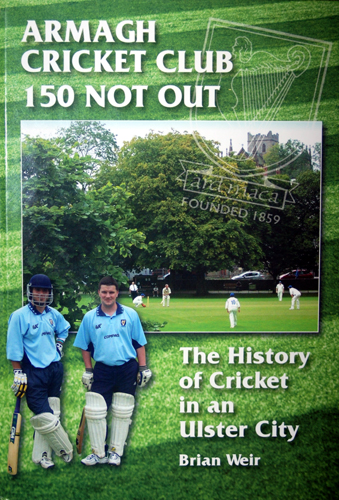
 ...written by their long-serving stalwart Brian Weir.
...written by their long-serving stalwart Brian Weir.
Armagh Cricket Club 150 not out…the History of Cricket in an Ulster City’ is a 648-page tome that traces the origins of cricket at the famous Mall as far back as the 1840s. What is particularly impressive is the author’s meticulous research of the early years when newspaper reports lacked the detail and accuracy of later years.
Brian’s passion for the subject shines through in virtually every page, and his pain-staking collation of club statistics in the Appendices is a formidable achievement in its own right, and will be a comprehensive record that students of local cricket will be able to draw upon in future years.
The author has taken the traditional chronological approach to the subject and over 111 chapters traced everything and anything that moulded the history of this fine club. He is also to be complimented in resisting the temptation to prostitute his work with advertisements, and while the potential revenue is important, a history of such importance deserves to stand on its own right. And that’s more reason why cricket lovers throughout Ireland should purchase a copy of the book, especially coming up to Christmas when unique cricket gifts are rare.
Armagh Cricket Club was one of the founding members of the Northern Cricket Union and in the union’s embryonic years the club reached the final stages of the Senior Challenge Cup on a regular basis. Brian plays down the club’s disagreement with the union in 1890 over the cup final date, and the intransigence that led to their withdrawal, but it was a rare blemish for a club that was to play an important part in the development of cricket in rural Ulster. IronicallyArmagh never won the senior cup, although they reached four senior cup finals in the first nine years of the competition, and competed with Sion Mills in the epic 1947 final. However, perhaps the greatest years in the club’s history were between the wars when they won the senior league on three occasions. It was an era when the club produced some of the finest players in Ulster cricket, and understandably they have become legends of Armaghcricket. Brian has given us an excellent account of their contributions to the team’s success and placed on permanent record the outstanding talents of the Barnes brothers Jackie and Bobby, Bob and Billy McKinley, Charles Raynor, Tom Ward and Wilfred McDonough. The narrative also deals passionately with some of the characters who ran the club and the leading administrators who gave Trojan service to the club over many years.
Without stealing the author’s thunder, I really enjoyed his account of the last fifty years and in particular the roles played by another generation of the Greats of Armagh cricket. Players like Leslie Spearman, George Elliott, Lloyd Armstrong, Harry Eadie, Ivan Anderson, and of course the inimitable Reggie Stinson, a prolific record-breaker over three decades and almost 600 appearances for the club. I was also pleased to see the contribution of other key personalities being recognized in a tangible way. Personalities like genial Joe Vaughan, the doyen of Irish umpires, the inimitable Hammie Ewart, fast bowling poet Ivan Forster, former club secretary Seamus Duffy, Marty McConville, George Breakey, and an old friend Phil Homan. It was painful re-living Armagh’s epic elimination of cup holders North Down in the 1st round of the 1982 competition and the role played by the mercurial Uday Joshi and the swash-buckling Trevor Barnes. The performances of the Armagh overseas professionals are well documented, as are the achievements of all the teams in the modern era, albeit at a much more modest level than in former years.
If there has to be a criticism then it is the absence of a Contents page for easy reference and an index to guide the researcher looking for specific information, as this book is not a start to finish read unless you are an Armagh stalwart or a local cricket historian. If you are, then you have a work of art to enjoy for many years.
Well done Brian Weir and Armagh Cricket Club for honouring the history of your club in such a memorable way.
For those seeking a copy of the book contact Brian Weir at b.weir@btinternet.com
Clarence Hiles
Editor








